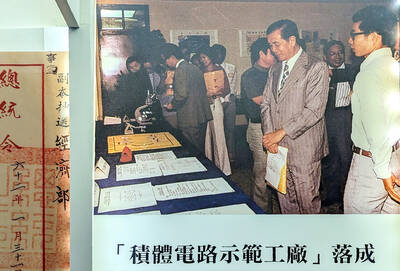New immigrants and migrant workers from Southeast Asian countries long ago became part of Taiwanese society. Yet their stories and experiences are rarely covered in the mainstream media, let alone on the big screen. Detours to Paradise (歧路天堂), the feature debut by film critic, scholar and English teacher Rich Lee (李奇), is an admirable attempt at portraying the country’s undocumented foreign laborers as real people and addressing their plight in an arresting story that stars a strong multinational cast from Indonesia, Thailand and Taiwan.
The film centers on Setia (Lola Amaria), an undocumented migrant worker from Indonesia who drifts from Taoyuan to Taipei working odd jobs for a meager living. Her lover Supayong (Banlop Lomnoi) is a Thai construction worker. In each other’s arms, the two find mutual comfort and solace, conversing in simple Mandarin and dreaming that one day they will have a comfy bed to share.
At the massage parlor where she works as a cleaning lady, Setia grows close to Wonpen (Niki Wu, 吳立琪), a Thai worker who changes her identity to re-enter the country. Soon after Wonpen leaves, Setia switches jobs to work at a noodle shop where she meets retired movie star Fei Man-guang (Yang Kuei-mei, 楊貴媚). Paralyzed from the waist down, Fei is a suicidal heavy drinker who is addicted to painkillers.
Fei gradually accepts Setia as her caretaker. However, the story takes an unexpected turn when Setia discovers that her new employer was responsible for the car accident that killed her older sister, who worked as Fei’s maid. Meanwhile, the police catch Supayong and he faces imminent deportation.
In the end, Setia is left alone in an unforgiving country. Like countless others, she continues to plod along as an undocumented migrant despite the hardship.
With the participation of Hou Hsiao-hsien’s (侯孝賢) filmmaking comrades including cinematographer Lee Ping-bing (李屏賓), editor Liao Ching-sung (廖慶松) and art director Huang Wen-ying (黃文英), Detours to Paradise exudes a sense of realism that is reminiscent of Taiwanese New Wave cinema. Slow pacing, long takes shot from a distance and minimal dialogue recall the early work of Hou and Tsai Ming-liang (蔡明亮).
Lee shows a flair for storytelling through the film’s mise en scene. The scene in which Setia is seen standing alone in a scrapyard shortly after she arrives in Taipei tersely conveys the runaway laborer’s powerlessness amid the hostile environment. An inescapable sense of confinement is present even in the scene in which Setia and Lomnoi sleep soundly in a hotel room as the camera pans to reveal the iron lattice window.
The film takes a melodramatic turn when Yang’s character Fei enters the picture. The cinematography and art direction become abstract and Yang’s acting more stylistic, which contrast the film’s overall tone. This section’s incoherent style, though a flaw to some, effectively portrays the collision between two worlds. The slightly theatrical treatment of Fei’s life suggests that what is perceived as normal in Taiwan is, in fact, exotic and alien to Setia.
The strong multinational cast turns in naturalistic performances that enhance the film’s slices-of-life feel. Indonesian actress and film director Amaria comes off as a sympathetic lead with her absorbingly understated performance. Noted for his work in Tropical Malady by Cannes-winning director Apichatpong Weerasethakul, non-professional actor Lomnoi from Thailand possesses natural charisma and a strong presence that recalls Lee Kang-sheng (李康生) in Tsai’s works.
Taiwanese actress Wu, who, through her convincing performance as the Thai servant, demonstrates great potential as a serious actor.
Though disconnected at times, Detours to Paradise is a commendable piece of filmmaking and shows that the spirit of New Wave cinema is still alive and kicking.

Oct. 27 to Nov. 2 Over a breakfast of soymilk and fried dough costing less than NT$400, seven officials and engineers agreed on a NT$400 million plan — unaware that it would mark the beginning of Taiwan’s semiconductor empire. It was a cold February morning in 1974. Gathered at the unassuming shop were Economics minister Sun Yun-hsuan (孫運璿), director-general of Transportation and Communications Kao Yu-shu (高玉樹), Industrial Technology Research Institute (ITRI) president Wang Chao-chen (王兆振), Telecommunications Laboratories director Kang Pao-huang (康寶煌), Executive Yuan secretary-general Fei Hua (費驊), director-general of Telecommunications Fang Hsien-chi (方賢齊) and Radio Corporation of America (RCA) Laboratories director Pan
The consensus on the Chinese Nationalist Party (KMT) chair race is that Cheng Li-wun (鄭麗文) ran a populist, ideological back-to-basics campaign and soundly defeated former Taipei mayor Hau Lung-bin (郝龍斌), the candidate backed by the big institutional players. Cheng tapped into a wave of popular enthusiasm within the KMT, while the institutional players’ get-out-the-vote abilities fell flat, suggesting their power has weakened significantly. Yet, a closer look at the race paints a more complicated picture, raising questions about some analysts’ conclusions, including my own. TURNOUT Here is a surprising statistic: Turnout was 130,678, or 39.46 percent of the 331,145 eligible party

The classic warmth of a good old-fashioned izakaya beckons you in, all cozy nooks and dark wood finishes, as tables order a third round and waiters sling tapas-sized bites and assorted — sometimes unidentifiable — skewered meats. But there’s a romantic hush about this Ximending (西門町) hotspot, with cocktails savored, plating elegant and never rushed and daters and diners lit by candlelight and chandelier. Each chair is mismatched and the assorted tables appear to be the fanciest picks from a nearby flea market. A naked sewing mannequin stands in a dimly lit corner, adorned with antique mirrors and draped foliage

The election of Cheng Li-wun (鄭麗文) as chair of the Chinese Nationalist Party (KMT) marked a triumphant return of pride in the “Chinese” in the party name. Cheng wants Taiwanese to be proud to call themselves Chinese again. The unambiguous winner was a return to the KMT ideology that formed in the early 2000s under then chairman Lien Chan (連戰) and president Ma Ying-jeou (馬英九) put into practice as far as he could, until ultimately thwarted by hundreds of thousands of protestors thronging the streets in what became known as the Sunflower movement in 2014. Cheng is an unambiguous Chinese ethnonationalist,